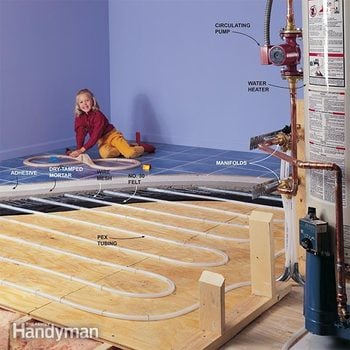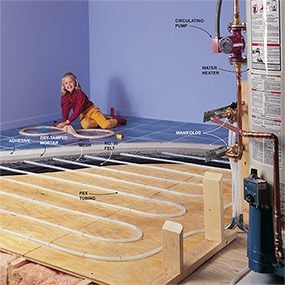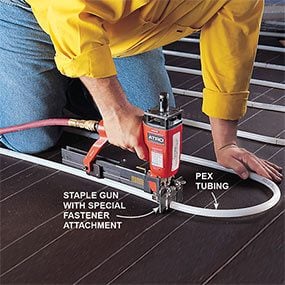How Hydronic Radiant Floor Heating Works
Updated: Oct. 31, 2019Cozy heat for new construction, additions and remodels

If you want to add an addition but your furnace can't handle the additional load, think about installing hydronic radiant floor heating. This will make your addition a warm and cozy without upgrading your furnace.
How hydronic radiant floor heating works
How Does Radiant Heat Work?
Unlike forced-air heating, which works by blowing warm air through large ducts, a hydronic system uses a dedicated water heater or a boiler (or even your existing water heater) as a heat source. A circulating pump moves the hot water through the PEX tubing and back to the heater. Because there can be no joints in the PEX tubing in the floor, uncut lengths of tubing snake through the floor, starting and ending at a manifold. The manifold balances the water in individual loops (lengths of tubing) and vents the system. The water returns to the bottom of the water heater near the drain about 10 degrees cooler than when it left.
What to look for in a hydronic radiant floor heating system
For truly even heat, choose a system that circulates hot water through code-approved plastic tubing (like PEX) that’s embedded in a layer of material and covered by ceramic tile flooring. The material can be light-weight concrete, Gypcrete or dry-tamped mortar. This cement-like layer, combined with the tile, makes up a great mass that stores the heat for a long time and continues to radiate it even when the water’s not circulating. This constant warmth can greatly increase the comfort of a room, especially in cold climates.
The cost per square foot for a hydronic system will depend on where you live and the size of the job. With a 300-sq.-ft. addition, expect to pay about over $1,500 to have the actual system installed (including water heater, tubing, pump and manifold). Then there’s the cost of embedding the tubing. For a fairly small job, the most economical choice is to hire a tile professional to embed the tubing in dry-tamped mortar. That should cost less than $4.00 per sq. ft. Then add the cost of the finished floor. Tile is the best choice.
The cost of a hydronic system for an addition may be about the same as the cost of another furnace (vs. replacing). However, your operating costs will be lower for the hydronic system, the water heater won’t take up as much space as a furnace and ductwork, and you’ll probably be more comfortable. To find more information or a hydronics specialist, search “hydronic radiant floor heat” on the web.


